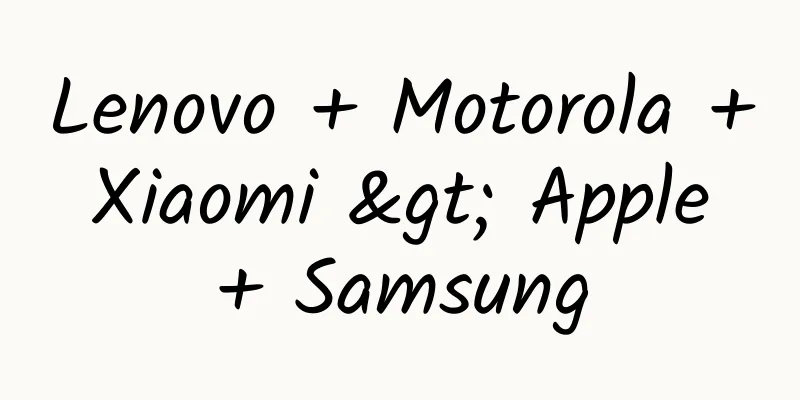Lenovo + Motorola + Xiaomi > Apple + Samsung

|
Remember this past Thursday, remember October 30th. If you care about the smartphone industry, you may have already sensed the extraordinary nature of this day. And its significance as a key node will become clearer the more you look back in the next few years. On the morning of October 30, 2014, the news was all about Xiaomi becoming the world's third largest mobile phone manufacturer, and in the evening Lenovo announced the completion of its acquisition of Motorola Mobility. On that day, the glass ceiling that had been blocking Samsung, Apple and many Android mobile phone manufacturers for two and a half years was broken. The Duopoly and the 7% Ceiling in the Smartphone Industry In the first quarter of 2012, Samsung's shipments surpassed Apple, and the duopoly in the smartphone field was formally formed. Nokia and Blackberry declined, and many Android manufacturers rose strongly. However, starting from the second quarter of 2012, Samsung and Apple firmly maintained the top two positions and suppressed the rest of the manufacturers. No matter how the third place changed, from Nokia to Blackberry, to LG and Huawei, no manufacturer's global market share could exceed 7% again. The 7% market share seems to be a transparent glass plate, blocking the upward path of Android manufacturers. At the worst time, apart from Samsung and Apple, no company's market share could exceed 5%. Huawei once narrowed the gap in the second quarter of 2014, but it was only 6.7%. Shipments are growing, but market share cannot be broken. Under the glass plate, the future looks bright, but there is no way out. Only by breaking this obstacle first can the duopoly of Samsung and Apple be shaken. Lenovo merges with Motorola, Xiaomi grows rapidly This situation can only be broken if there is a reorganization or new players join the challenge. The interesting thing is that these two things happened at the same time. On the evening of the 30th, Lenovo officially announced the completion of its acquisition of Motorola Mobility. The combined market share of Lenovo and Moto reached about 8%, breaking through the transparent ceiling in one fell swoop. Xiaomi took the third place in global smartphone shipments with a dazzlingly high growth rate, up 211.3% year-on-year, while Samsung became the only major mobile phone manufacturer to see a year-on-year decline in both shipments and market share. Lei Jun said in a speech in Chengdu recently that he was "surprised and happy" to get the third place this quarter. He also revealed Xiaomi's future plan: 100 million shipments in 2015, Xiaomi may enter the list of the world's top five companies in the next two years, and in terms of internationalization, it will take one to two years to become the leader in India, enter markets such as Brazil, and then enter the European and American markets after "surrounding the cities from the countryside", and become the world's largest mobile phone manufacturer in five to ten years. The battlefield is in the low-end As mature markets such as the United States and Japan are saturated and the Chinese market is also on the way to saturation, the growth of global smartphone shipments is increasingly dependent on emerging markets. For example, India and Brazil are in the stage of rapid transition from feature phones to smartphones, just like China three years ago. The most popular products in such markets are cheap smartphones priced at $200 or even less than $100. The story that happened in the Chinese market will be repeated in these countries in the next few years. Xiaomi has made initial success in expanding into the international market, Lenovo has Motorola, and ZTE and Huawei have gained ground in many global markets due to their identities as communication infrastructure companies and their relationships with operators. Chinese mobile phone manufacturers will generally benefit from this wave, and the competition among them will become increasingly fierce. In the next few years, the number of users who will switch from feature phones to smartphones will be in the billions. This is the "next billion" that companies like Google and Facebook are talking about. This is also the hope of Chinese mobile phone manufacturers such as Xiaomi, Lenovo, ZTE, and Huawei. These users are not Apple's consumer group, and Samsung seems to have not yet adapted to the changes in the mid- and low-end market. China is a market where smartphones mature quickly, so Chinese media seem to be a little slow to respond to this trend. You should know that 70% of new mobile phones sold in the Indian market are feature phones, so the smartphone market has great potential. In the Indian market alone, the annual shipment of smartphones will exceed 100 million next year. Xiaomi and Motorola (Lenovo) will take a large share of this market. Apple has a weak presence in India, and Samsung's share is declining. Lenovo, Xiaomi and Huawei, in addition to competing with each other, will definitely aim to see who can surpass Apple in terms of shipments. This will take some time to achieve, but the global emerging market transition from feature phones to smartphones is on their side. In addition, if Samsung cannot regain its market rhythm, how many years can it keep its throne as the largest mobile phone manufacturer? The iPhone was released in 2007, and Samsung surpassed Apple in 2012 to establish a duopoly. In between, there was the rise and fall of Nokia, the ups and downs of HTC, the struggle of Motorola, the stumbling of BlackBerry, and the rise of China's smartphone industry. Now the duopoly is beginning to shake. Who will be at the top in five years? Will it be Xiaomi? Of course, there is not a huge gap between the companies, and it is possible that no one can replicate Samsung's 12-year glory. |
<<: In the era of mobile Internet, where will text messages go?
>>: You read that right! Google and Facebook are competing fiercely for the Chinese market
Recommend
Byton plans to conduct an IPO, having previously obtained the qualification to build a car for 1 yuan
On October 29, Beijing time, Carsten Breitfeld, C...
How to master oCPC and efficiently complete customer acquisition and conversion?
Mobile Internet access, mobile payment, online sh...
Ma Liangkun, a famous doctor at Peking Union Medical College: A must-have course for a good pregnancy, from pregnancy preparation to postpartum care, 40 weeks of full escort
Famous doctor Ma Liangkun from Peking Union Medic...
What is cause marketing? How should companies conduct charity marketing?
Many people think that we are far away from chari...
Is the magic weight loss drug recommended by Musk, which can help you lose 10 pounds with one injection, really that magical?
Review expert: Wu Xi, deputy chief physician of t...
The new infrastructure with a 34 trillion yuan investment has computing power as its core driving force
The foundation of digital transformation is "...
How to reduce user churn through effective operational activities?
The “Double 12” promotion kicked off the year-end...
Want to do a marketing activity but don’t know how to write a plan? Check out this article!
Many people always feel like they don’t know wher...
Android source code: Custom date and time control (SelectTime)
Functional classification: Life Supported platfor...
How to apply star-chasing publicity channels to brand marketing?
The channels used by star-chasing fans to promote...
Behind the "price increase" of domestic smartphones, has the "low-price era" really passed?
At the beginning of the new year, domestic smartp...
China's "Big Goose", the world's first
Author: Wen Lele Geese may have been domesticated...
How to play with free channels - bringing in 300,000 users in three months
When a new APP product enters the market, how to ...
Love to visit, love to hold grudges... Let’s dig up the embarrassing stories of the giant whales!
Excerpted from: Inside and Outside the Classroom ...
Beyondsoft Global Headquarters Building Completed
On October 16, 2014, Beyondsoft, Asia's leadi...









